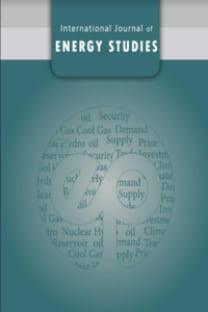Fuel estimation of commercial aircraft for the climb-out phase using gaussian process regression model
Fuel estimation of commercial aircraft for the climb-out phase using gaussian process regression model
___
- [1] Stolzer AJ. Fuel consumption modeling of a transport category aircraft using flight operations quality assurance data: a literature review. Journal of Air Transportation 2002; 7(1): 93.
- [2] Lee DS, Pitari G, Grewe V, Gierens K, Penner JE, Petzold A, Prather MJ, Schumann U, Bais A, Berntsen T, Iachetti D, Lim LL, Sausen R. Transport impacts on atmosphere and climate: aviation, Atmospheric Environment 2010; 44(37): 4678-4734.
- [3] Larsson J, Elofsson A, Sterner T, Åkerman J. International and national climate policies for aviation: a review. Climate Policy 2019; 19(6): 787-799.
- [4] Brzozowski K. Kotlarz W. Modelling of air pollution on a military airfield. Atmospheric Environment 2005; 39(33): 6130-6139.
- [5] Senzig DA, Fleming GG, Iovinelli RJ. Modeling of terminal-area airplane fuel consumption. Journal of Aircraft 2009; 46(4): 1089-1093.
- [6] Collins B. Estimation of aircraft fuel consumption, Journal of Aircraft 1982; 19(11): 969–975.
- [7] Patterson J, Noel GJ, Senzig DA, Roof CJ, Fleming GG. Analysis of departure and arrival profiles using real-time aircraft data. Journal of Aircraft 2009; 46(4): 1094-1103.
- [8] Kim HJ, Baik H. Empirical method for estimating aircraft fuel consumption in ground operations. Transportation Research Record 2020; 2674(12): 385-394.
- [9] Turgut ET, Rosen MA. Relationship between fuel consumption and altitude for commercial aircraft during descent: preliminary assessment with a genetic algorithm. Aerospace Science and Technology 2012; 17(1): 65-73.
- [10] Zhu Q, Pei J, Liu X, Zhou Z. Analyzing commercial aircraft fuel consumption during descent: A case study using an improved K-means clustering algorithm. Journal of Cleaner Production 2019; 223: 869-882.
- [11] Oruc R., Baklacioglu T. Modelling of fuel flow-rate of commercial aircraft for the climbing flight using cuckoo search algorithm. Aircraft Engineering and Aerospace Technology 2020; 92(3): 495-501
- [12] Seymour K, Held M, Georges G, Boulouchos K. Fuel Estimation in Air Transportation: Modeling global fuel consumption for commercial aviation. Transportation Research Part D: Transport and Environment 2020; 88: 102528.
- [13] Luo W, Wu Z, Chen C. An Aircraft Fuel Flow Model of Cruise Phase Based on LSTM and QAR Data. In 2020 13th International Symposium on Computational Intelligence and Design (ISCID) (pp. 118-121). IEEE. 2020.
- [14] Baumann S, Klingauf U. Modeling of aircraft fuel consumption using machine learning algorithms. CEAS Aeronautical Journal 2020; 11(1): 277-287.
- [15] Baklacioglu T. Modeling the fuel flow-rate of transport aircraft during flight phases using genetic algorithm-optimized neural networks. Aerospace Science and Technology 2016; 49:52-62
- [16] Elbir T. Estimation of engine emissions from commercial aircraft at a midsized Turkish airport. Journal of Environmental Engineering 2008; 134(3): 210-215.
- [17] Rice CC. Validation of approach and climb-out times-in-mode for aircraft emissions computation. Transportation research record 2003; 1850(1): 79-82.
- [18] Chati YS, Balakrishnan H. Data-driven modeling of aircraft engine fuel burn in climb out and approach. Transportation Research Record 2018; 2672(29): 1-11.
- [19] Liati A, Schreiber D, Alpert PA, Liao Y, Brem BT, Arroyo PC, Eggenschwiler, PD. Aircraft soot from conventional fuels and biofuels during ground idle and climb-out conditions: Electron microscopy and X-ray micro- spectroscopy. Environmental Pollution 2019; 247: 658-667.
- [20] Chilongola FD, Ahyudanari E. Aviation and aircraft engine emissions at Juanda International Airport. Materials Science and Engineering 2019; 645(1): 012022.
- [21] Raposo F, Borja R, Ibelli-Bianco C. Predictive regression models for biochemical methane potential tests of biomass samples: Pitfalls and challenges of laboratory measurements. Renewable and Sustainable Energy Reviews 2020; 127: 109890.
- [22] Liu K, Hu X, Wei Z, Li Y, Jiang Y. Modified Gaussian process regression models for cyclic capacity prediction of lithium-ion batteries. IEEE Transactions on Transportation Electrification 2019; 5(4): 1225-1236.
- [23] Chen X, Huang J, Yi M. Cost estimation for general aviation aircrafts using regression models and variable importance in projection analysis. Journal of Cleaner Production, 2020; 256: 120648.
- [24] D'Agostino R. Goodness-of-fit-techniques. Routledge. 2017.
- [25] Hagquist C, Stenbeck M. Goodness of fit in regression analysis–R 2 and G 2 reconsidered. Quality and Quantity 1998; 32(3): 229-245.
- Yayın Aralığı: Yılda 4 Sayı
- Başlangıç: 2016
- Yayıncı: Türkiye Enerji Stratejileri ve Politikaları Araştırma Merkezi (TESPAM)
Decontamination applications in primary circuit equipment of nuclear power plants
Berk SÜRÜCÜ, Murat ÖZTÜRK, Erdem ÇİFTÇİ, Azim Doğuş TUNCER
Production and determination of properties of ethanol from mango and orange peels
Anas BALA, Richard Balthi MSHELİA, Jamilu Ya'u MUHAMMAD, M ADAM
The challenges and serviceability of solar power: suggestion on solving the Nigeria energy crisis
